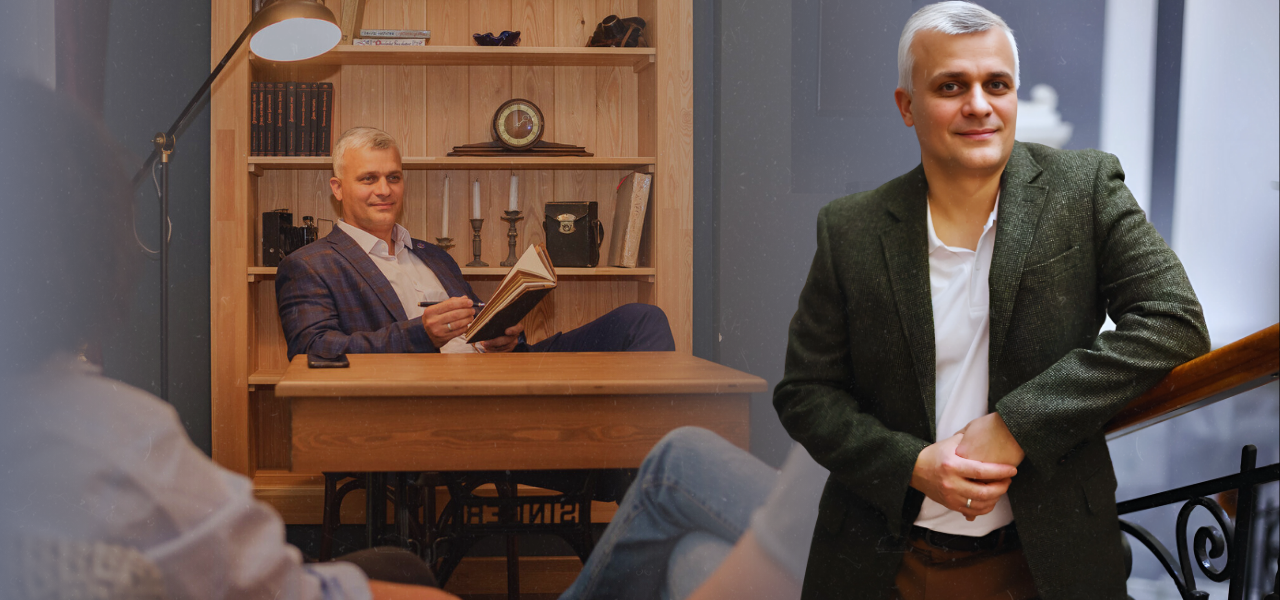Why Is It Important for People with Sight Loss to Be Online? Interview with a typhlopsychologist
Today, the InviOcean team sat down with Mikhail Shchurov, a psychologist and psychotherapist specializing in typhlopsychology, to explore why the digital world represents freedom for blind and visually impaired people — and why online gaming matters so much.

Hi Mike! It’s a pleasure to have a chat with you today! Could you start by telling us a bit about your experience working with blind and visually impaired individuals?
Sure! A little over two years ago, I was invited to take part in an art therapy session as part of a project called “All the Colors of the World Except Black,” held in Kaluga at the Innovation Cultural Center. The sessions were led by Anna Iosifovna Senatova, a well-respected artist, who asked me to join as a psychologist for a group of blind and visually impaired participants.
Back then, I didn’t have a background in typhlopsychology, but everything clicked. I started getting regular requests for consultations and therapy sessions, particularly from the Russian Society of the Blind. That’s how my ongoing work began — at first through private practice, but just about a year ago, they asked me to contribute to their educational program. I developed a series of 48 sessions, mostly focused on drawing.
The approach was pretty unique because many of the participants can’t see colors, and some have chromatopsia, meaning they perceive colors inaccurately. So we focused on textures — the feel of paper, its density, the thickness of paint strokes, much like the heavy layering seen in Zurab Tsereteli’s artwork.
The participants showed great interest — texture mattered a lot to them. Some even noticed the scent of the paint and could distinguish between acrylic and oil paint. Some could even guess the color by smell!
That’s how my partnership with the Russian Society of the Blind started — it’s now an official partnership. These days, I mostly provide counseling, focusing on societal integration, adaptation, communication needs, and self-actualization.
Have you seen examples where the internet has opened up the world for blind individuals?
Absolutely. I’m impressed by how well members of the Society use the internet and devices like tablets and smartphones. Even those with just 1% vision attend lectures and view images — maybe not fully, but they’re definitely engaging with the technology. This opens up communication for them, especially since they mainly use voice messages in chats. Staying connected is crucial.
Think about it: when we feel anxious, we can just meet a friend and talk. For blind people, that’s a whole quest — they need a guide, a cane, help navigating the street, often asking for directions multiple times. It’s a big effort.
The internet compensates for this lack of in-person interaction, letting them simply be themselves and connect without all those real-world obstacles.
How does poor accessibility — like unreliable screen readers or unreadable buttons — affect someone’s sense of self?
It’s a huge factor. People are resourceful and try to overcome these barriers, but when it comes to theater or film, the biggest complaint is the lack of audio description.
In our project, for example, we have a wonderful colleague, Dasha, who adapts paintings with detailed descriptions and provides commentary for performances. Most importantly, we let participants touch the canvases — a rare but vital experience.
For an artist, this might seem like a nightmare, but for blind viewers, it’s essential.
Audio descriptions bridge the gap — in movies, a narrator explains what’s happening on the screen, and that makes a big difference.
We also worked with metaphorical cards, which posed a challenge because participants couldn’t see the images, so we had to describe each card aloud. Their emotional sensitivity is often heightened; they perceive the world differently, which we must respect.
One client even suggested creating tactile metaphorical cards. I thought, surely those exist. But after researching, I found none. He said, “That would be so useful.” Technology evolves, yet such simple tools are still missing. He joked about starting a business. Honestly, it’s a great idea.
So, from a psychological perspective, would you say audio descriptions are what’s most lacking?
Yes. Our main goal is an integration to help people feel whole and equal, with the same opportunities as everyone else.
But modern films often have flashes, explosions, and rapid action with very little dialogue, making audio descriptions even more critical.
Imagine a blind person at the cinema, struggling to find their seat because staff aren’t trained to assist, hearing only fragments of dialogue. Having headphones with a voiceover explaining the action would make them feel part of the culture — even pop culture.
What cognitive and emotional effects do you see in blind people who are beginning to explore the digital world?
Isolation and sensory deprivation are serious challenges. Not everyone has the personality to cope well. The lack of communication leads to anxiety, depression, memory issues, decreased motivation, and a fading desire to learn.
Sighted people have dozens or hundreds of social contacts; people with sight loss might have ten times fewer. Without social interaction, what’s the point of learning? Even basic information is harder to process and takes more time and energy.
Do blind beginners tend to feel anxious or fearful about technology? How can we help them integrate faster?
Definitely. I’ve done a lot of volunteer work and truly believe in grassroots initiatives. Volunteers are passionate and willing to support, teach, and simply be there.
Many blind people want smartphones and laptops, but don’t know how to use them.
Our project focuses on creativity — painting, sculpting — and many apps can be adapted with larger fonts, vibration feedback, and audio cues. Volunteers who create projects or join grants play a vital role. This is civil society in action.
What psychological processes are involved when blind people learn new skills?
Primarily, attention — without visual input, auditory and tactile senses become highly developed. Sometimes it feels like they literally “feel” their surroundings with their skin. Their concentration, empathy, and sensitivity increase, along with profound gratitude. They crave information and connection.
Sometimes, participants talk non-stop during sessions — a good sign, as they lack physical contact like hugs and closeness, which are important and therapeutic.
Are games a way to establish connection?
Absolutely. Even a little play helps people open up.
Play is one of humanity’s oldest ways to connect, ease anxiety, and feel included.
How does playing online games affect confidence, initiative, and decision-making?
It depends on the game. I’ve seen large, professionally run online games — like Dungeons & Dragons — adapted and played with great joy. It’s magical, honestly. People live full lives through gaming. Real-life settings aren’t always ideal, but online games can be fantastic alternatives for blind and visually impaired people.
Players from different cities and countries break down barriers and play together.
How would you explain to skeptics that games for blind people aren’t just entertainment, but vital social access?
I don’t understand their skepticism. Play is dynamic and alive. We’re talking about deprivation — the lack of connection. Games bring people to life.
Players laugh, express emotions, argue — that’s real life.
Sighted people have an abundance of social interaction; they face far fewer limits.
What can volunteers, developers, and audio describers do to support these users?
We have to talk and listen to people.
Some clients suggested metaphorical cards.
Surveys, interviews, and live meetings help identify real needs. We must respond, not assume. Volunteers are the heart of this work — essential support. Feedback, brainstorming, and collaboration are crucial to building effective programs.
What can the digital world offer inclusion that offline can’t?
It shortens distances and saves time.
It’s accessible.
Audio content — books with audio description, adapted software — is at hand. Blind or visually impaired people can’t always leave their homes, but online everything is within reach.
Now, AI can read, translate, and adapt books. That’s crucial.
Are there risks online?
Yes, for everyone. The digital world can’t fully replace face-to-face contact.
People risk isolation and inactivity. I always tell clients: keep moving! Exercise at home if you can’t go out. It’s simple but vital.
You mentioned emotional engagement in games. Can online gaming be training for real psychological skills?
Yes, definitely. Many lack self-regulation and emotional control. They missed typical social experiences in childhood.
Some have friends they argue and make up with repeatedly — that’s how social skills develop. Their social circles are smaller and vulnerability is higher, so they tend to overact.
Games create safe spaces to relax, drop masks, reveal struggles. This is the first step to healing. They play, argue, create — specialists observe and guide. It’s a powerful diagnostic tool.
How does learning digital skills impact self-worth and the right to be heard?
It’s deeply tied to self-expression and voice. Digital skills open communication channels — calls, chats, discussions. This helps people express themselves and boosts self-esteem.
They feel seen and valued. Online platforms help offset the lack of in-person contact.
Why is it important for blind people not only to be users but creators of content and communities?
I’ve met incredibly creative and confident people.
Being able to express talents digitally is vital for growth. In our group, some draw to “see” and compensate for lack of visual contact. They inspire others and build supportive spaces.
What would you say to a blind person afraid of digital tech?
It opens a whole new world you never imagined.
People lose faith and accept limits — then, suddenly, a miracle: the digital world opens up. Communication, education, games, books, movies with audio description — they come alive.
It bridges the gap between person and society. Take the first step — it’s scary, but worth it.
What about sighted people who underestimate digital accessibility?
We’re all the same.
We take tech access for granted, but for some, it’s a struggle. Software, interfaces, buttons aren’t always accessible.
Accessibility applies to digital spaces too.
In the ideal future, accessible websites and tech will be standard. Our job is to build products that open digital worlds to everyone.
Explore exciting and accessible games for the blind in our blog to stay connected!
